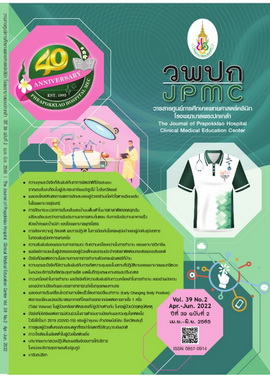The Relationship between Emotional Labor and Burnout among Registered Nurses
Main Article Content
Abstract
BACKGROUND: Nurses are required to perform emotional labor as part of their job. Nurses are expected to manage their emotions appropriately and with a high level of control to do their jobs efficiently. If emotional labor is not in appropriate level, it may lead to burnout. So, it is essential to understand the effect of nurses’ emotional labor on burnout.
OBJECTIVES: To study the level of emotional labor, prevalence, and level of burnout and to examine relationship between two strategies of emotional labor (surface acting, deep acting) and burnout, among registered nurses.
METHODS: The study design was a cross-sectional analytical study. Data were collected, between July and august 2021, from 217 registered nurses who were working at a general hospital in Ayutthaya Province, by using emotional labor questionnaire and Maslach burnout inventory (MBI). Data were analyzed by descriptive statistics and Pearson’s correlation analyses.
RESULTS: The results reveal that surface acting was low and deep acting was moderate. The prevalence of overall burnout was 20.3%. The results indicated moderate levels of emotional exhaustion and reduced personal accomplishment but low level of depersonalization. There was a positive relationship between surface acting and emotional exhaustion as well as depersonalization (r=0.35, p<0.001, r=0.34, p<0.001 respectively) while there was a negative relationship between surface acting and personal accomplishment (r=-0.26, p<0.001). There was a negative relationship between deep acting and emotional exhaustion as well as depersonalization (r=-0.62, p<0.001, r=-0.24, p<0.001 respectively).
CONCLUSIONS: The findings suggest that the intervention program of emotional labor that enhance using deep acting should be developed in order to reduce burnout among registered nurses.
Article Details

This work is licensed under a Creative Commons Attribution-NonCommercial-NoDerivatives 4.0 International License.
References
Montgomery A , Maslach C. Burnout in health professionals. In: bLlewellyn CD, Ayers S, McManus C, Newman S, Petrie KJ, Revenson TA, editors. Cambridge Handbook of Psychology, Health and Medicine. 3rd ed. Cambridge: Cambridge University Press; 2019. p. 353-6.
Yang C, Chen A. Emotional labor: a comprehensive literature review. Human Systems Management 2021;40 :479-501.
Jeung DY, Kim C, Chang SJ. Emotional labor and burnout: aeview of the literature. Yonsei Med J 2018;59:187-93.
Delgado C, Upton D, Ranse K, Furness T, Foster K. Nurses' resilience and the emotional labour of nursing work: An integrative review of empirical literature. Int J Nurs Stud 2017; 70:71-88.
Kim JS. Emotional labor strategies, stress, and burnout among hospital nurses: a path analysis. J NursScholarsh 2020;52:105-12.
Hulley SB, Cummings SR. Designing clinical research. New York: Wolters Kluwer; 2013.
Summawart S. Burnout among the staff nurses in Ramathibodi hospital [dissertation]. Bangkok:Mahidol University; 1989.
Manakarn A. Emotional labor and work-family conflict predicting job stress of customer service bank employees. SDU Research Journal 2018; 14(2):50-66.
Rujivararat A. Frontline employees stress when employing emotional labor strategy [dissertation].Bangkok:Silpakorn University; 2016.
Woo T, Ho R, Tang A, Tam W. Global prevalence of burnout symptoms amongnurses: a systematic review and meta-analysis. J Psychiatr Res 2020;123:9-20.
Mousavi SV, Ramezani M, Salehi I, Hosseinkhanzadeh AA, Sheikholeslami F. The relationship between burnout dimensions and psychological symptoms (Depression, Anxiety and Stress) among nurses. J Holist Nurs Midwifery 2017;27(2) :37-43.
Kakandee N, Cheevakasemsook A, Iwichitkhun D. Job burnout of generation Y professional nurses at government hospital. Journal of the royal Thai army nurses 2020;21(1):293-301.
Halbesleben J, Neveu JP, Paustian‐Underdahl SC, Westman M. Getting to the "COR": understanding the role of resources in conservation of resources theory. Journal of Management 2014;40:1334-64.
Mesmer-Magnus J, DeChurch LA, Wax A. Moving emotional labor beyond surface and deep acting: a discordance congruence perspective. Organizational Psychology Review 2012;2:6-53.

